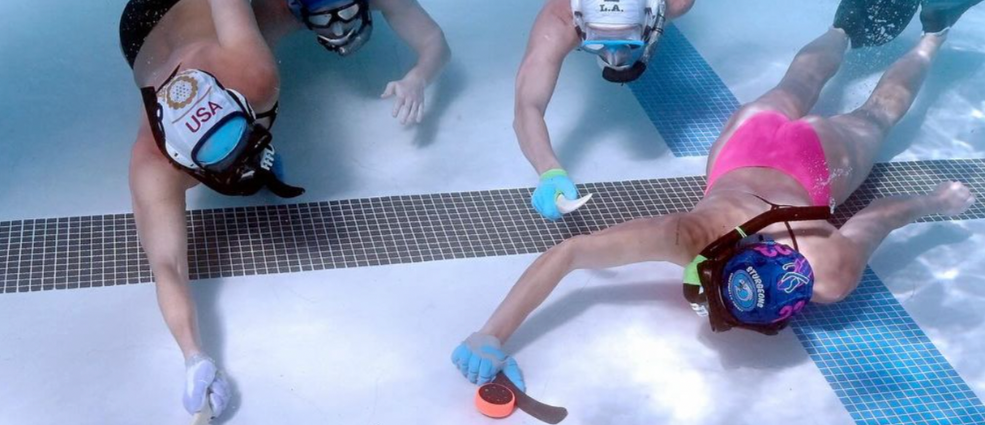
Fresh Fandoms is exploring niche sports this week, like pickleball, underwater hockey, and more, discovering their origins, appeal, and the vibrant communities around them.

Welcome to this week's edition of Fresh Fandoms by Fandom Daily, where we dive into the vibrant world of sports that are capturing the hearts of enthusiasts globally. This time, we're exploring a selection of games that blend physical dexterity, strategic gameplay, and cultural heritage into their core.
From the dynamic courts of pickleball to the intriguing depths of underwater hockey, each sport offers a unique blend of excitement and community, appealing to a diverse array of fans and players. Join us as we delve into these fascinating activities, uncovering the stories behind their rise and the communities that champion them.
Pickleball
Pickleball, a vibrant and fast-growing racket sport, cleverly merges the dynamics of tennis, badminton, and table tennis into an engaging game that captivates players of various skill levels and ages. Developed in the mid-1960s on Bainbridge Island near Seattle, Washington, this sport was the brainchild of three fathers—Joel Pritchard, Bill Bell, and Barney McCallum — aiming to entertain their bored families during the summer. They crafted a game that could be easily played on a badminton-sized court using paddles originally fashioned from plywood and a perforated plastic ball, which are now standardized with advanced composite materials for competitive play.
Played on a 20x44-foot court, which is about a third of the size of a tennis court, pickleball offers a more intimate and less physically demanding environment, making it accessible to a broader range of fitness levels. The smaller play area facilitates constant interaction among players, enhancing its social appeal, which is a significant draw of the sport. According to the official USA Pickleball website, the rules are straightforward, combining elements like the tennis-style serve and scoring with the fast-paced volleying of table tennis, all of which make it easy for beginners to pick up and enjoy quickly.
Over the decades, pickleball has evolved from a backyard family activity to a sport with organized competition at all levels, including professional. The USA Pickleball Association (USAPA) oversees the sport's rules and sanctions official tournaments, including the prestigious USA Pickleball National Championships. These tournaments not only highlight the sport's competitive nature but also celebrate its inclusive spirit.
The sport's recent surge in popularity can also be attributed to its strong community presence, bolstered by social media and local community events. Platforms like Facebook, Instagram, and dedicated pickleball forums serve as vital hubs for sharing tips, arranging games, and discussing equipment, which helps to maintain high engagement levels among players. One notable online community is "The Kitchen Pickleball," a reference to the non-volley zone in pickleball known as "the kitchen." This group is a significant online gathering space where enthusiasts share experiences, organize events, and connect over their shared passion for the sport.
Moreover, pickleball's appeal as a year-round, all-weather sport increases its accessibility. Many parks, recreational centers, and retirement communities now feature dedicated pickleball courts, reflecting its status as one of the fastest-growing sports in the United States. Its popularity has also spread internationally, with countries around the world forming leagues and federations to promote the sport.
Underwater Hockey
Underwater hockey, also known as Octopush, is a unique sport played at the bottom of a swimming pool. Teams of six use small sticks to push a weighted puck into the opponents' goal. This sport requires exceptional swimming skills, breath control, and teamwork, making it both challenging and exciting (ESPN). The Underwater Hockey World Championships and regional tournaments have fostered a dedicated global fanbase that appreciates the sport’s distinct underwater environment and the athleticism required to compete.
The playing environment of underwater hockey is highly unique and challenging. Players must be adept at holding their breath, as they dive to the bottom of the pool to strike the puck or block an opponent's shot. The sport requires not only exceptional swimming skills and precise breath control but also strategic teamwork and spatial awareness, as players navigate and coordinate their movements in three dimensions.
Underwater hockey is typically played in a 25-meter pool with goals set up at both ends. The games consist of two halves, each lasting approximately 10 to 15 minutes, with a short halftime break. Players wear fins, masks, snorkels, and protective gloves and headgear, enhancing their swimming capabilities and safety underwater.
The sport has grown in popularity and is now governed by the World Underwater Federation (CMAS), which organizes the Underwater Hockey World Championships. These international championships, along with regional tournaments across continents, have cultivated a dedicated and passionate global fanbase. Enthusiasts appreciate the sport’s unique underwater environment, which adds an extra layer of excitement and spectacle. Watching the players glide effortlessly below the surface, orchestrating strategic plays in silence, offers a stark contrast to more traditional, terrestrial team sports.
As underwater hockey continues to grow, it is increasingly recognized not just as a recreational activity but as a competitive sport that offers a compelling blend of physical challenge and strategic gameplay. It appeals to those who seek an unconventional sport that pushes the boundaries of human athletic and respiratory capabilities, and it fosters a tight-knit community of players and fans united by their love for this unique aquatic pursuit.
Chess Boxing
Chess boxing is a captivating hybrid sport that uniquely combines the cerebral challenges of speed chess with the physical demands of boxing in alternating rounds. The sport tests competitors in both mental agility and physical strength, offering a rare test of endurance and strategic thinking. This innovative sport was conceived by French comic book artist Enki Bilal and was brought to real-life competition by Dutch performance artist Iepe Rubingh as an artistic performance in 2003. It has since evolved into a competitive sport that garners global attention.
The structure of a chess boxing match is designed to test the versatility and resilience of its participants. Matches consist of up to eleven alternating rounds—six rounds of chess, each four minutes long, and five rounds of boxing, each three minutes long. Competitors must switch gears rapidly; they wear headphones during the chess rounds to ensure concentration is not broken by the audience’s reactions. The winner is determined by either a knockout or technical knockout in the boxing rounds, a checkmate in the chess rounds, or a judge's decision if no knockout or checkmate occurs. If a stalemate arises in the chess game, the outcome in the boxing ring becomes the deciding factor, which adds a thrilling element of unpredictability to the contest.
Originating in Berlin, Germany, the sport quickly spread across Europe and to broader international audiences, facilitated by the founding of the World Chess Boxing Association (WCBO). The WCBO has been instrumental in establishing rules and standards that have shaped chess boxing into a formalized sport. Its appeal is broad, attracting fans of strategy games as well as combat sports, and it challenges the stereotype that physical and mental prowess are mutually exclusive. Events have been held globally, with the World Chess Boxing Association playing a key role in the sport’s development and growing fanbase. Chess boxing’s unique blend of intellectual and physical challenge attracts a diverse audience.
Hurling
Hurling is an ancient Irish sport often described as the fastest field game in the world. Players use a small ball called a sliotar and a wooden stick called a hurley, combining elements of field hockey, lacrosse, and soccer. While it has always been integral to Irish culture, hurling has recently gained international attention. Clubs are forming in the United States, Canada, and Australia, expanding its passionate fanbase.
Hurling, often touted as the world's fastest field game, is a traditional Irish sport that dates back over 3000 years. It combines elements from field hockey, lacrosse, and baseball, requiring players to use a wooden stick called a hurley to hit a small ball known as a sliotar between the opposing team's goalposts. While deeply rooted in Irish culture, hurling has begun to capture the imagination of international audiences, with clubs forming across North America and Australia. The All-Ireland Senior Hurling Championship is the pinnacle of the sport, drawing large crowds and broadcast audiences captivated by the game's speed and skill.
Sepak Takraw
Sepak Takraw, often referred to as kick volleyball, is a mesmerizing sport that combines the aerial prowess and agility of volleyball with the foot skills of soccer. Originating in the 15th century in the Malay-Thai Peninsula, this dynamic sport has evolved into a popular competitive activity across Southeast Asia and beyond. Played with a rattan ball on a court that is indeed similar to a badminton court in size and layout, sepak takraw is distinguished by its strict rule that players can use any part of their body except their arms and hands to touch the ball (History of Soccer).
The game is typically played by two teams of three players each, known as 'regus'. The agility and acrobatic ability required to propel the ball over a high net using kicks, headers, and knee strikes make it not only challenging but also visually striking. Each match consists of two or three sets, with teams racing to reach 21 points first, mirroring badminton's scoring system. The speed and coordination displayed in sepak takraw matches are unparalleled, featuring spins, jumps, and kicks that often send athletes soaring through the air.
Internationally, sepak takraw's prominence has been boosted significantly by its inclusion in multi-sport events such as the Asian Games and the SEA Games, which have introduced the sport to a broader audience. The establishment of the Sepak Takraw World Championship has provided a dedicated platform to showcase the highest levels of skill and competition, propelling the sport onto the global stage. These high-profile competitions have been instrumental in spreading awareness and excitement about sepak takraw, attracting new fans and participants from all over the world who are captivated by its unique blend of traditional athletic skills and modern competitive dynamics.
These niche sports are not only gaining popularity but also fostering tight-knit communities of passionate fans. Their unique blends of physical and mental challenges, combined with the excitement of their gameplay, ensure they will continue to grow and attract new followers.
Photo Credit: @underwaterhockey_usa.

Patrick Mahomes’ torn ACL ends...
Read More...
MLB All-Stars, country favorit...
Read More...
Travis Kelce’s fiery sideline...
Read More...
Adele is rumored for the 2026...
Read More...

Brooke Hogan publicly question...
Read More...